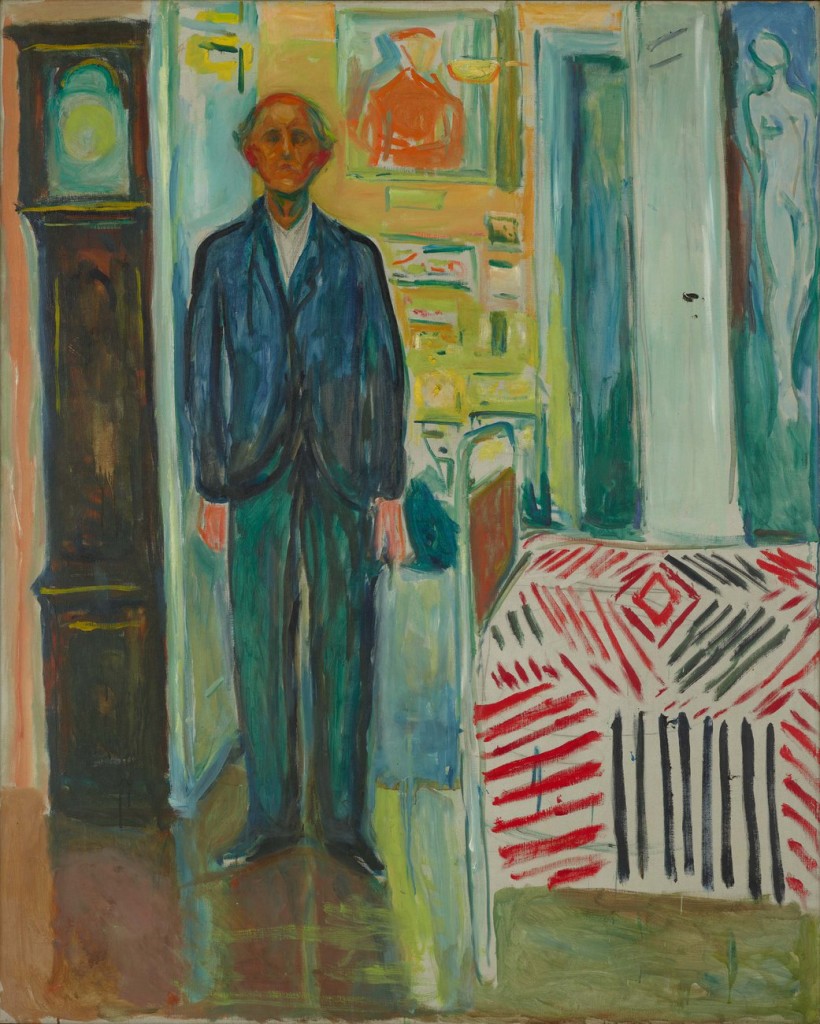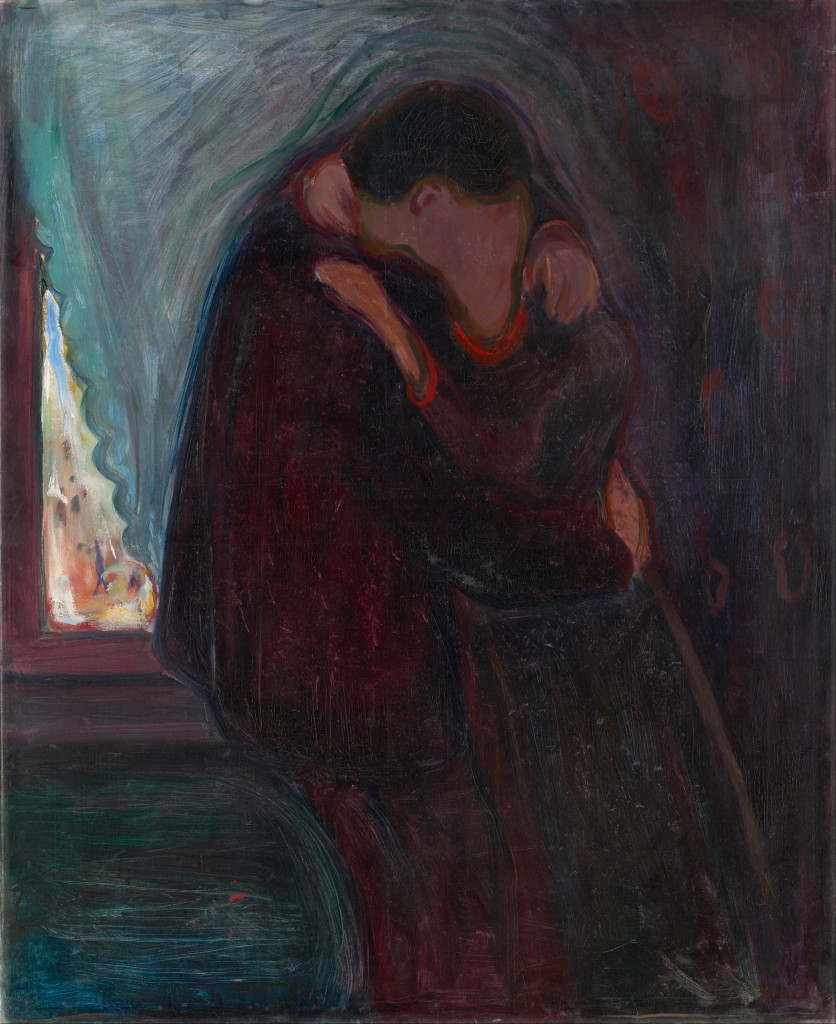
The must-see exhibit of Norwegian expressionist painter Edvard Munch, which debuted earlier this year at SFMoMA, ends in less than a week, on Monday, October 9. If you haven’t already, it is time to tap into your psychological yearning, leave your bed behind, and experience the palpable sublimity of Edvard Munch. Color, form, pattern, and paint. Love, death, anguish, and age. Edvard Munch bleeds brilliance, and you simply must be there to witness his resurrection.
In its press release, SFMoMA dubbed Edvard Munch: Between the Clock and the Bed as “profoundly human and technically daring”. The exhibit eloquently displays a brutally honest translation of life through Munch’s avant-garde turn-of-the-century, expressionistic style.
Rather than the usual chronology many exhibits sport, each gallery is refreshingly organized by a theme prominent in Munch’s work. The first room is entitled “The Self.” Upon entrance, the painting for which the show was named glowed in my face: Between the Clock and Bed, painted in 1943, was one of the last creations ever to flow from Munch’s brushes. The image is simple. As an old man facing alcoholism, partial paralysis, and hallucinations, Munch illustrates himself, gaunt, but alive. His image stands casually between a clock and a bed. Within the frame, death is ever present; the grandfather clock has no hands nor numbers, and raw canvas peaks through the layers of paints, perhaps a nod to an unfinished life. As canvas stays canvas, time remains timeless. But in death, time and creation die too. An outline of a young woman floats above the bed, a portrait of what could be — intimacy, purity, youth — within a self-portrait of what is. The self cannot escape age and the self cannot escape time. The painting, on the other hand, lives on forever.
Leaving the principal painting behind, I was faced with decisions. The exhibit maintains an open floor plan with no specific path, allowing the viewers to wander somewhat freely. Almost like the meandering of life. The winding life of Munch, and the winding life of the viewer.
Munch’s famed thick, vibrant brush strokes swept me through the galleries, soon leading me to a small room entitled “Nocturnes.” The room was dark and stirring, a respite off to the side of the beaten path. The room was crowded, and every elbow bump and shoulder touch brought me back to reality, out of the overpowering dreamlike atmosphere radiating from the paintings surrounding me. The walls showcase The Storm (1893), Moonlight (1893), Night in Saint-Cloud (1893), and Starry Night (1922). In 1890, Munch made a declaration against naturalism. This new, immense, painterly style pulses throughout this gallery. He decided to depict “living people who breathe and feel and suffer and love.” With psychoanalysis on the rise, Munch tapped into Freudian drives. Each painting became an attempt to capture the human condition, resulting in a sort of muted psychological chaos. Each image emanates Nietzsche’s nihilism. Pain, despair, melancholia, and drama surface through the beating blocks of anonymous color. Still, somehow, there seems to be hope.

In Moonlight, there are unfinished windows, asking for the viewer to fill them with their own hope on the other side. In The Storm, a small brush stroke of pink resides on a tree in the foreground. Starry Night retreats into a pink horizon. Each painting, even in its melancholic anguish, seems to define a kind of beauty. It’s not just a bleak wasteland hidden among our subconscious. No, there’s something more. Munch shows us that beautiful something behind it all.
The next gallery I wandered into was “Beside the Bed.” Intimate in name already, before even seeing the first frame. Each picture showcases charged domestic imagery, dynamic and life-like, with a clearly reckless application of paint. The paintings break down the boundary between life and art, multi-dimensional and filled with depth. Staying true to the gallery title, many frames show women paralleled with the beds, sensual innuendo dripping from the painterly strokes. But as I transported to Munch’s personal domestic life, I was jarringly brought back by noisy children weaving quickly in and out of the galleries.
A bizarre juxtaposition. Carefree and content. Unaware of the profoundly evocative and emotionally draining images in the background.
The next three galleries welcomed me with uneasy, but open arms. “Hallucinations” was the first. The rhythm, dynamism, and garish colors turned back to the psychological. Each painting revolutionary in its bold and brave style. This time, the paintings reached a jarringly visceral response. Madonna (1895-97) hangs paramount. The curvilinear strokes framing the woman pushes her towards the viewer. Purposefully left unfinished, the viewer’s imagination is left to fill the star woman, as she drips with dark sexual innuendo. Shocking, yet invigorating.
I let Madonna slip from my gaze and moved on to “In the Sick Room”. Munch declared he “was born dying.” I could almost smell the odor of death from the grotesque coloring. His technical skill allowed for a profound immersion.

No matter which path you take, the exhibit’s curators save the best for last, reserving for the final room the deepest human sentiment of them all: “Love.” Just as the exhibit culminates, life too peaks not with the end of time, but rather with a lasting power. A lasting power that will always transcend space and time. The lasting power of love.
Before I quite let go of my path through Munch, The Kiss (1897), hanging in the corner of “Love”, drew me in. As my eyes welled with tears, I was engulfed by two lovers melting into each other. It was a kiss that would last forever, immortalized in paint. And as I turned away, I knew it was an exhibit that would last forever as well, in my heart and quite possibly, in your heart too.
Munch resurrected. Indeed.
Photos from SFMoMA and the Google Art Project.
